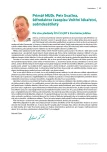Diabetic foot infections
Authors:
Lenka Ryšková
Authors‘ workplace:
Ústav klinické mikrobiologie LF UK a FN Hradec Králové, přednostka doc. MUDr. Helena Žemličková, Ph. D.
Published in:
Vnitř Lék 2015; 61(6): 587-591
Category:
Předneseno na mezioborovém sympoziu s postgraduálním zaměřením „Diabetik – společný pacient diabetologa a ortopeda“ 10. října 2014 v Hradci Králové.
Overview
Diabetic foot infections (DFIs) are serious problems in persons with diabetes, about 10 to 25 % of patients with diabetes develop a foot ulcer and 60 % of them are infected. DFIs cause morbidity, limit mobility, worsen patients’ quality of life. Infections are classified as mild, moderate, or severe. Most DFIs are polymicrobial, with Gram-positive cocci (especially staphylococci), Gram-negative bacilli and obligate anaerobes. Successful therapy of DFI requires proper topical care and often includes surgical interventions but appropriate antibiotic treatment plays a key role. Initial antimicrobial therapy of these infections is usually empirical, the antibiotic regimen should be based on the severity of the infection. Definitive therapy should then be tailored according to the results of culture and susceptibility tests from a reliably obtained specimen.
Keywords:
culture findings – diabetic foot infections – empirical antibiotic therapy – osteomyelitis
Sources
1. Lavery LA, Armstrong DG, Wunderlich RP et al. Risk factors for foot infections in individuals with diabetes. Diabetes Care 2006; 29(6): 1288–1293.
2. Jeffcoate WJ, Lipsky BA Controversies in diagnosing a managing osteomyelitis of the foot in diabetes. Clin Infect Dis 2004; 39(Suppl 2): S115-S122.
3. Frykberg RG. A summary of guidelines for managing the diabetic foot. Adv Skin Wound Care 2005; 18(4): 209–214.
4. Beneš J. Infekční lékařství. Galén: Praha 2009. ISBN 978–80–7262–644–1.
5. Lipsky BA, Berendt AR, Cornia PB et al. Executive summary: 2012 Infectious Diseases Society of America Clinical Practice Guideline for the Diagnosis and Treatment of Diabetic Foot Infections. Clin Infect Dis 2012; 54(12): 1679–1684.
6. Lavery LA, Armstrong DG, Murdoch DP et al. Validation of the Infectious Diseases Society of America’s diabetic foot infection classification system. Clin Infect Dis 2007; 44(4): 562–565.
7. Jindrák V, Hedlová D, Urbášková P et al. Antibiotická politika a prevence infekcí v nemocnici. Mladá fronta: Praha 2014: 334–335. ISBN 978–80–204–2815–8.
8. Citron DM, Goldstein EJC, Merriam CV et al. Bacteriology of moderate-to-severe diabetic foot infections and in vitro activity of antimicrobial agents. J Clin Microbiol 2007; 45(9): 2819–2828.
9. Bowler PG, Duerden BI, Armstrong DG. Wound microbiology and associated approaches to wound management. Clin Microbiol Rev 2001; 14(2): 244–269.
10. Akinyoola AL, Adegbehingbe OO, Aboderin AO. Therapeutic decision in chronic osteomyelitis: sinus track culture versus intraoperative bone culture. Arch Orthop Trauma Surg 2009; 129(4): 449–453.
11. Mutluoglu M, Uzun G, Turhan V et al. How reliable are cultures of specimens from superficial swabs compared with those of deep tissue in patients with diabetic foot ulcers? J Diabetes Complications 2012; 26(3): 225–229.
12. Zuluaga AF, Galvis W, Jaimes F et al. Lack of microbiological concordance between bone and non-bone specimens in chronic osteomyelitis: an observational study. BMC Infect Dis 2002; 2: 8. Dostupné z DOI: <http://doi: 10.1186/1471–2334–2–8>.
13. Malone M, Bowling FL, Gannass et al. Deep wound cultures correlate well with bone biopsy culture in diabetic foot osteomyelitis. Diabetes Metab Res Rev 2013; 29(7): 546–550.
14. Senneville E, Morant H, Descamps D et al. Needle puncture and transcutaneous bone biopsy cultures are inconsistent in patients with diabetes and suspected osteomyelitis of the foot. Clin Infect Dis 2009; 48(7): 888–893.
15. Votava M et al. Lékařská mikrobiologie. Vyšetřovací metody. Neptun: Brno 2010: 253–254. ISBN 978–80–86850–04–7.
16. Senneville E, Lombart A, Beltrand E et al. Outcome of diabetic foot osteomyelitis treated nonsurgically: a retrospective cohort study. Diabetes Care 2008; 31(4): 637–642.
17. Gardner S. Cultures of diabetic foot ulcers without clinical signs of infection do not predict outcomes. Diabetes Care 2014; 37(10): 2693–2701.
18. Chantelau E, Tanudjaja T, Altenhofer F et al. Antibiotic treatment for uncomplicated neuropathic forefoot ulcers in diabetes: a controlled trial. Diabet Med 1996; 13(2): 156–159.
19. Hartemann-Heurtier A, Robert J, Jacqueminet S et al. Diabetic foot ulcer and multidrug-resistant organisms: risk factors and impact. Diabet Med 2004; 21(7): 710–715.
20. Lazzarini L, Lipsky BA, Mader JT. Antibiotic treatment of osteomyelitis: what have we learned from 30 years of clinical trials? Int J Infect Dis 2005; 9(3): 127–138.
21. Matsuura GT, Barg N. Update on the Antimicrobial Management of Foot Infections in Patients With Diabetes. Clin Diabetes 2013; 31(2): 59–65.
22. Spellberg B, Lipsky BA. Systemic antibiotic therapy for chronic osteomyelitis in adults. Clin Infect Dis 2012; 54(3): 393–407.
23. Lew DP, Waldvogel FA. Osteomyelitis. Lancet 2004; 364(9431): 369–379.
Labels
Diabetology Endocrinology Internal medicineArticle was published in
Internal Medicine

2015 Issue 6
Most read in this issue
- Diagnosing and therapy of gout
- Alveolar echinococcosis – rare cystic disease of the liver – editorial
- Guidelines of Czech Association for Thrombosis and Haemostasis of the Czech Medical Association of J. E. Purkyně for safety treatment with new oral anticoagulants (NOAC) – dabigatran etexilate, apixaban and rivaroxaban
- “Stressful holiday” – takotsubo cardiomyopathy
